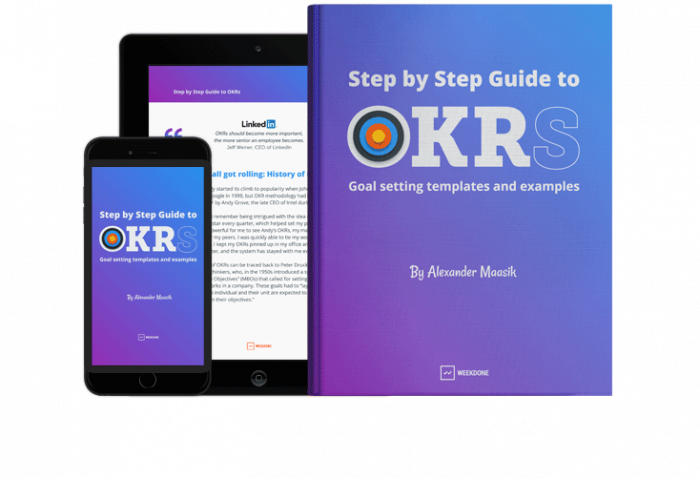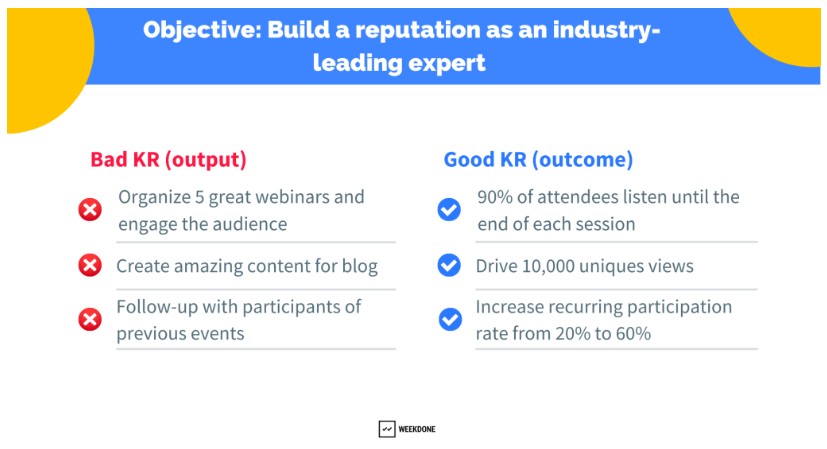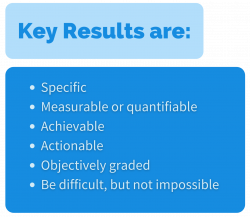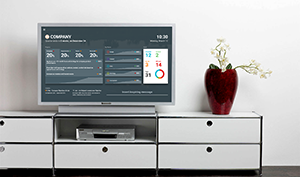Did you know that industry-leading companies like Amazon, Spotify, and Google use OKRs? The Objectives and Key Results (OKR) methodology is a goal management framework used across businesses of all sizes – from startups, SMEs, to large corporations.
This scalable framework is best used with complete company buy-in. That means it won’t do you any good if only the leadership team believes in it! From the CEO to department heads, teams, and individual employees – everyone should understand the benefits and get excited about the possibilities.
OKRs have proven to improve a company’s productivity and efficiency. This makes it all the more important Operations teams to get on board!
In this practical guide to goal setting find examples to help you get started with creating impactful Objectives and Key Results (OKRs). Help your teams and your company implement one of the most successful goal setting frameworks currently out there.
We also have free OKR templates available for the Excel and Word users out there. Check them out.
In this article, we will focus on Operations OKRs, why it’s a great framework, how to create OKRs, and 15 OKR examples to provide ideas for your team.
OKRs for Operations: Focus Areas
Operations Management has a heavy focus on the administrative tasks of the company while determining ways to ensure business processes are running effectively and efficiently.
Focus on the “O” of OKRs
Some of the different focus areas for Operations Objectives could include:
- Allocation of resources
- Determining budgets for teams
- Inventory control and management
- People management
As you can see, those are big responsibilities. Setting Objectives based on existing problem areas, where you see room for improvement, and the current state of the organization will help color the Objective that the department sets for the quarter.
Remember: If your OKR isn’t actionable, meaning you can’t think of activities to work on that will make an impact toward that desired outcome, then get back to the drawing board and think again!
Watch these videos to learn more OKR best practices
Delve into the “KRs” of OKRs
After creating Objectives with consensus from the whole team, the next step is to set Key Results. This will give clear direction through measurable values that act as stepping stones toward achieving the Objective.
Good Key Results for Operations may include metrics like:
- Percentage of risks mitigated or identified
- Customer lifetime value
- Accounts receivable turnover
- Delivery time
Think of the metrics you’re currently tracking in your Operations team, what needs improvement? Is it achievable in three months? Consider how this improvement could bring your company closer to its overall mission.
Here are some useful resources to understand how to set Key Results and the difference with KPIs:
How to Create OKRs for Operations
The best practice when creating Operations OKRs is to begin with a retrospective discussion. Whether this is the first time setting OKRs or if you are an OKR Champion, it’s important to ask these questions in your quarterly review sessions:
- What are the problems we addressed?
- What did we learn from that?
- What went well?
- What could still be improved?
- What questions are left unanswered?
15 OKR Examples for Operations
Here are some examples of Operations OKRs we think may be useful as you begin creating, setting, and tracking OKRs on your own.
#1. Improve the company-wide request process to improve efficiency
KR1: Identify 30 common requests and automate the process with templates
KR2: Decrease request backlog by 35% overall (or by team/department)
KR3: Increase team satisfaction by 40%
#2. Utilize emerging technologies to enhance productivity
KR1: Automate 90% of required tasks
KR2: Adopt emerging technologies to streamline 100% of operations
KR3: Improve product delivery and quality by 80%
#3. Streamline the internal document management system (DMS) to go paperless for better collaboration
KR1: Select and launch a new document-sharing platform by the end of the quarter
KR2: Migrate 100% of documents or files to the new system and cloud
KR3: Ensure all teams are aware and use the new platform to organize their files
4. Create an excellent company culture to increase employee satisfaction
KR1: Enhance the onboarding process by the end of the quarter
KR2: Improve employee retention by 55%
KR3: Rollout a quarterly satisfaction survey and improve employee engagement rate by 50%
#5. Adopt best practices to maximize office/work productivity
KR1: Allocate at least 16 hours of training hours for all employees in the quarter
KR2: Ensure all executives adopt the inbox zero rule by the end of the month
KR3: Review and assess the effectiveness of meetings attended on a bimonthly basis
#6. Control costs to meet financial targets
KR1: Implement a performance management dashboard to understand costs by Q4
KR2: Identify 10 cost-saving areas and recommend improvements to decision-makers
KR3: Create a roadmap complete at least 80% improvements in the quarter
#7. Increase customer satisfaction to meet and exceed revenue goals
KR1: Select and launch the NPS monitoring tool by the end of the quarter
KR2: Achieve NPS of 8 from 10 customers and define the benchmark for success
KR3: Increase NPS by at least 2 points by end of the quarter
#8. Improve the quality of meetings between departments to increase productivity
KR1: Audit 80% of meetings and analyze findings by the end of the month
KR2: Get insights from 75% of employees about meetings, through anonymous surveys
KR3: Create and share the audit report and survey findings with leadership by Q4
#9. Create a world-class work environment to build high-performing teams
KR1: Ensure 100% of employees have access to digital tools and video conferencing technology
KR2: Decrease office spending on supplies by 15%
KR3: Revamp the career growth path for all employees and reduce the turnover rate by 75%
#10. Implement a learning and development system to boost employees’ strengths
KR1: Develop 5 training modules for different departments
KR2: Ensure 95% of employees complete 3 hours of training in the quarter
KR3: Educate at least 10 employees to add 10 new how-to articles by Q4
#11. Streamline the expense planning process to increase cost efficiency
KR1: Identify 4 processes where bulk purchases can be made
KR2: Identify 3 key vendors and negotiate discounts
KR3: Reduce expenses by 40% every quarter
#12. Automate repetitive tasks to save time and improve the effectiveness
KR1: Identify 10 repetitive tasks across all departments by the end of the month
KR2: Find 2 automation tools to streamline at least 5 repetitive tasks by the end of the quarter
KR3: Conduct a survey 3 weeks after the end of the quarter and gather feedback on performance
#13. Meet staffing levels with a new scheduling system to improve workload management
KR1: Identify staffing needs of all departments by the end of the month
KR2: Assess historical data to understand seasonal influxes or demand changes by the end of the quarter
KR3: By Q4, design and launch a new scheduling system to ensure proper staffing for all shifts and seasons
#14. Identify reasons for customer churn to improve retention rate
KR1: Obtain a 70% response rate for a survey on customer churn and retention
KR2: Interview 50% of the respondents to find out the factors for customer churn
KR3: Create an improvement strategy roadmap for a quarter based on findings
#15. Reduce contract negotiation time to close deals faster
KR1: Assess the contract negotiation process to identify areas of improvement by the end of the month
KR2: Analyze 10 contracts and review 5 sections to identify risks
KR3: Reduce time between initial negotiation and close of contract from 2 weeks to 1 week
Manage Operations OKRs Better With Weekdone
Weekdone makes setting, tracking, and reporting updates on OKRs easy.
Our OKR software provides interactive dashboards to make the entire OKR process more effective. The system supports a transparent work culture ensuring the successful implementation of a goal management solution.
Build high-performing teams that are accountable, collectively track progress, and let every team member have clarity about the big picture. Ensure to keep the best practices in mind through the entire journey of setting and tracking OKRs – from onboarding, OKR training, to implementation.
Learn more about how it works, take a walkthrough or use the platform to get real work done.



